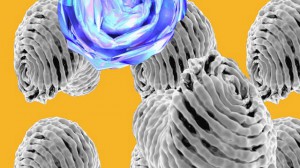Vince McKelvie makes sculptural gifs and software environments that crack open the well of kinetic sculpture. His pieces explore texture, shape and movement with digital rendering software influencing what is possible, as the material stuff (marble or found objects) of traditional sculpture. His gifs pair glossy digital textures with shapes that dissolve and remake themselves in infinite loops, visually recycling themselves as the form morphs.
In an interview with Giphy, the search engine just for gifs, McKelvie revealed the two-fold reason behind the explosion of gif art online “GIFs are the Polaroids of animation, they’re instant gratification.” Gifs reach audiences because they are animated without pressing play. They have the visual interest of moving images with the ease and immediacy of stills. That covers how audiences interact with the work, but there is another crucial reason for the rise of gifs.

Vince McKelvie
In the interview McKelvie continued, “It’s… important to me to be able to display my images in a dynamic context which would be difficult with other media.” Online it’s all about making work that is flexible, that can go where the eyes are. Unlike video, the previous home of animation online, which is trapped inside a video player, gifs are free to roam the web (unless we include Facebook, of course, a long hold-out in the widespread use of gifs online). Anywhere a still image is shown online, gifs are likely also compatible. Artists whose work is either exclusively or even just primarily made to be seen online have learned to create work that seamlessly transitions not just from browser to browser, each with their peculiar differences, but also between personal websites, Twitter feeds, Tumblr, DeviantArt, a whole variety of art collection sites and ultimately even inside other projects.

Vince McKelvie


